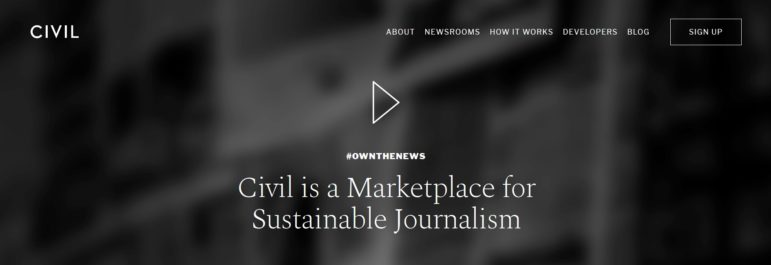 Shamus Toomey knows very little about blockchain technology, or the exotic new marketplace for journalism that it claims to offer.
Shamus Toomey knows very little about blockchain technology, or the exotic new marketplace for journalism that it claims to offer.
But his small news organization, Block Club Chicago, is about to launch on a sophisticated blockchain platform anyway, becoming one of 11 pioneering newsrooms that will publish on the decentralized system from this summer.
The veteran editor – who supervized a team at the Chicago Sun Times that won a Pulitzer Prize in 2011 – views the claimed benefits of the technology as nothing but a potential bonus. Having seen dozens of his reporters laid off in recent years, Toomey says he is simply glad to have found a new platform and energetic support that has allowed him to rehire some of those journalists and get back to doing the same investigations and news stories his team was doing before.
That platform, Civil, has attracted both excitement and skepticism in the media industry for its leverage of complicated technology, its recent infusion of $5 million in funding, its early media groups signing on some respected journalists and, above all, for the breathtaking scope of its ambition. Civil promises nothing less than to “turn the broken (journalism) model on its head” and to provide the new “canvas on which journalists can paint the future of their industry.”
The $5 million comes from ConsenSys, a top developer of Ethereum, the blockchain platform that Civil is based on. Of those funds, Civil is doling out $1 million to publishers like Block Club Chicago to enable it to build a constituency and create a testing ground for its new canvas.
According to its website, Civil seeks to restore eroding public trust in journalism by removing the influence of advertisers, corporate owners and propagandist news actors, and creating a new marketplace in which community-vetted journalists are accountable directly, and only, to readers.
Its co-founder Matt Coolidge told GIJN that – extraordinarily – he expects at least “a thousand” newsrooms globally to be publishing on the Civil platform by the end of 2018.
So far, the company has announced just seven of those – all US-based newsrooms, comprising about 50 journalists — that are to launch simultaneously on the platform sometime around mid-July. Coolidge revealed that an additional four startups had signed in April, including newsrooms in Southeast Asia, Egypt and Eastern Europe. Civil has provided startup funding for its “first fleet,” including the local news-focused Block Club Chicago; Sludge – an investigative and policy reporting site focused on Congress; Popula, an alternative news platform; and Documented, which will examine immigration issues in New York. It’s also making a 300,000 euro grant to the European Journalism Center, which – along with matching funds from the News Integrity Initiative – will be distributed to several emerging news organizations around Europe.
While independent experts interviewed by GIJN see Civil as an exciting and even necessary experiment, Civil is promoting its model to newsrooms as the go-to operating system for journalism.
“If you want to go find journalism on the internet,” says Coolidge, “ultimately, you’ll find two destinations: Civil, or anywhere else.”

In Tokens We Trust
While most readers will still access content through ordinary subscriptions, Civil claims it can make quality journalism more sustainable through a trust-building self-governance system enabled by cryptocurrency tokens.
Run and regulated on the blockchain, these tokens – to be distributed and purchased around launch day – are supposed to boost the quality and credibility of Civil’s journalism marketplace, allowing members of its engaged, token-holding community to vote on the suitability and ethical acceptability of applying newsrooms, and to challenge stories and reporters in terms of the agreed principles of the Civil “Constitution.”
The concept of the blockchain is that you can add one block of information to another block in an open, encrypted digital network so that the new block has a record of the transaction that cannot be tampered with. It has been hyped by some as “a new way to trust.” While the Bitcoin cryptocurrency is blockchain’s most famous application, Civil says a more useful comparison for its application in journalism is the crowdsourced governance of Wikipedia.
The base technology offers at least two immediate and uncontested benefits for news stories: they cannot be deleted from the internet — which has happened when publications are shut down and, with them, their archives — and they are virtually immune from direct censorship.
A third direct benefit flows from the Ethereum blockchain platform that Civil uses: “smart contracts” which automate transactions and eliminate middlemen. These contracts make it possible for independent reporters to bid on contract or mass-pitch stories and – with payments automatically made once conditions are met – there would be no need for freelancers to hound media organizations for payment.
But none of these are game-changing features for the industry. What’s needed — any clear-eyed, battle-weary editor will tell you — are sustainable sources of revenue and a trust-building mechanism that can grow reader audiences in a landscape compromised by fake news.
Show Us the Money
Matt DeRienzo is executive director of Local Independent Online News Publishers (LION), a US association devoted to supporting and developing journalism entrepreneurs.
Having discussed the model with Civil’s leadership, DeRienzo says he welcomes the effort, but is skeptical about its real-world effectiveness.
“Half of all newspaper staff in the US have lost their jobs in the past 15 years, so we welcome experimentation and new approaches,” he says. “We are very invested in the idea that in order to solve the problem of local news, we need thousands of sites to launch – we don’t believe there will be a centralized corporate solution. It’s going to come from the grass roots, and some of the principles Civil is talking about are in keeping with this community focus.
“But there is no silver bullet funding model, or tech platform, that’s going to suddenly make news entrepreneurship easy or lucrative. If you look at the Civil model, it comes down to community members willing to invest – whether that’s blockchain-based currency or simply with their time. This is really about convincing people to help pay for news. I think this is more a human issue than a tech issue.”
While Coolidge agrees on that point, he says blockchain provides the trust mechanism for any community of strangers to fully engage, and to do so with skin in the game.
“It is a self-governing, decentralized marketplace, and we need to instantiate the CVL Token which will represent ownership of the network,” he says. “The biggest differentiator is the self-governing nature of the platform; that’s the part that blockchain really does enable. It might only be a minority of users that engage on this level, but having a platform economy model in the same vein as an Amazon or an Ebay or an Uber is not in and of itself novel or complex. In journalism, it is. We’re just really building a marketplace between buyers and sellers, which, in this case, just happens to be readers and journalists.”
Coolidge says the initial focus will be on promoting investigative, local news and policy journalism – the very areas that are most poorly served by the advertising model, and are most important for informed societies.
But when repeatedly asked how the Civil model could generate new revenue for newsrooms, and replace ad revenue, Coolidge speaks, instead, about governance and registration.
Voting for Journalism
The registration application fee for newsrooms has not yet been disclosed, but GIJN understands that it will be in the range of a one-month studio apartment rental in a major US city: low enough, Coolidge says, to be widely accessible, but high enough to avoid frivolous applications.
And Civil has clearly thought deeply about down-the-road governance scenarios. For instance, Coolidge says that if a token-holding member wishes to challenge the application of a new newsroom, they need to risk value by placing a block of their own tokens in a pot. The applying newsroom would then need to match these challenge tokens ahead of a vote open to all token-holding members. The most votes win, and the losing participant’s tokens would be distributed 50 percent to the winning party, and 50 percent to those members who voted for the winning party.
Coolidge says that in a scenario where an ethically dubious newsroom — like, say, a newsroom headed by the right-wing white nationalist Richard Spencer — somehow won the vote, there would be a third-party appeals council to adjudicate, made up of free speech attorneys and journalism school deans.
But asked about how the Civil model could generate revenues to pay journalists, Coolidge speaks about capital funds raised for the “first fleet” of newsrooms, and the fact that newsrooms can use any business model they want, from paywall subscriptions to ad revenue. Which is, of course, what publishers are using now.
While stories about Civil frequently talk about the tokens as a direct funding mechanism or as an investment where the value of the cryptocurrency might increase, Coolidge is emphatic that the tokens “are not speculative.” The impression left is that Civil’s cryptocurrency mechanism might be an enabler of new revenue, rather than a source of it.
But Is It Necessary?
Michael McCarthy, who teaches blockchain application at Harvard’s Advanced Leadership Initiative, says the blockchain model cannot directly solve the lost ad revenue problem for newsrooms, unless a series of special conditions are met.
He says the tokens “could work” if all participants committed to not selling their work outside the network, and if smart contracts are leveraged efficiently – but even for that, the use of cryptocurrency may not be necessary.
McCarthy offers this analogy: “You can buy a bus to go to work, but you only need a vehicle for one, not 40. A bus will work — you just don’t need it. You can easily do this model without blockchain. (I think) Civil could do this (more simply) – just the way Amazon sells e-books.”
The community ecosystem that Civil proposes involves three circles of participation: reporters and developers at the core, followed by a medium circle of engaged community members who vote with tokens and a large circle of ordinary readers and subscribers, who pay in any currency.
LION’s DeRienzo says he is concerned about a potential lack of diversity in the middle, community circle in the model.
“Use of the blockchain technology is a heavily young, white male thing right now,” he says. “If you’re going to build local news on the basis of blockchain, it’s going to leave many people out, especially those most in need of a voice.”
But Coolidge insists that diversity is a central priority within the model, with tokens allocated to several non-profits and minorities-focused newsrooms, and, he points out, women represent the majority of the 13 staff members at Civil.

First Fleet: So far, Civil has officially signed up seven newsrooms to join them on their new blockchain-based platform, sometime before mid-July.
The Membership Effect
Coolidge does concede that widespread misunderstanding about the nature and role of blockchain technologies remains a challenge for Civil, notwithstanding the company’s numerous website explainers.
So growing the new marketplace may come down to Civil’s ability to do what journalists themselves are asked to do: show, don’t tell.
“As the Sludges and Populas have come out, we’re seeing a cascade effect,” he says. “Independent journalists and news startups see names signed up like Maria Bustillos, a very respected journalist from The New Yorker, or Tom Scocca, a respected editor at Gawker, and it sends a powerful message to their peers.”
David Moore, cofounder of Sludge, believes the Civil platform will help build an engaged community around his policy reporting site, while also making it easier to generate other revenue streams like micro-payments and even targeted donation appeals.
“We think it’s going to make a difference in connecting with our audience,” he says. “There is something like consensus now that the ad-driven model is not sufficient for even a modest-sized organization involved with local, investigative or policy journalism. So membership has to be a big part of the puzzle, and it’s best if membership can be augmented with micro-donations, or à la carte article support. The Civil network offers a really good community and design – how its tech works, and how readers will interact.”
But Damian Radcliffe, a professor of journalism at the University of Oregon, says the platform could pose some new risks for fledgling newsrooms, warning that the broader revenue value of blockchain platforms “is unproven.”
“Blockchain won’t be a panacea,” he says. “Newsrooms and media organizations will need to continue to diversify their revenue base, embracing a wide range of means to attract income. That traditional advertising revenues will continue to drop, for most publishers, seems pretty certain. We need bold, brave ideas to help support – and fund – the journalism of today, and the future. So, these experiments will be exciting to watch unfold.”
 Rowan Philp is a multiple award-winning journalist who has worked in more than two dozen countries. Currently based in Boston, Philp was the chief reporter and London bureau chief for South Africa’s Sunday Times for 15 years.
Rowan Philp is a multiple award-winning journalist who has worked in more than two dozen countries. Currently based in Boston, Philp was the chief reporter and London bureau chief for South Africa’s Sunday Times for 15 years.
